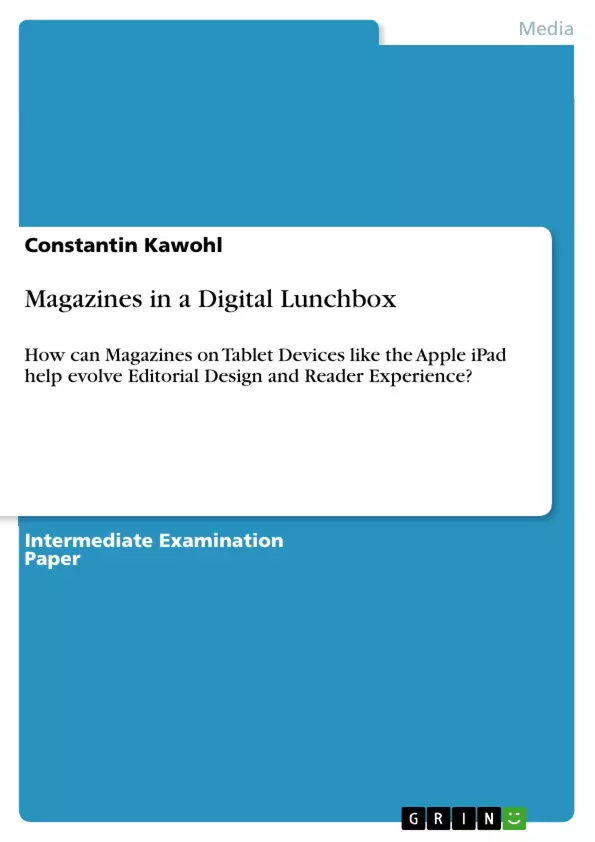Magazines today face unique challenges: Readers have learned that free, high quality content is ubiquitous on the Internet, that design is more than just an appealing layout, that attention spans are dynamic and media choices are overwhelming. The start of the iPad and the tablet device market leads many magazine producers to embrace this technology, from The New Yorker and TIME Magazine to Wired and Vogue. But doubts remain: Here comes another new market of media gadgets to challenge existing print magazine brands. How does it impact the way readers consume media? Will it be a vehicle for existing brands, or will it mostly spawn new ones? Will readers follow up on their online subscriptions when a free digital magazine is just a click away? These challenges need to be addressed, and by highlighting the differences between the iPad and “old media” print magazines, it can be shown that magazine producers can certainly use this technology to their advantages.
Bringing an existing magazine brand to the iPad may mean rethinking reader participation and experiences, the creative process and workflow of an editorial team may have to be reshaped, and the editorial design reinvented. Never have readers been more entitled to influence their media mix, but where can media producers draw a line? Apple’s tablet device is unique in that it combines a specific set of features on a particularly restrictive platform, and in its reception by a worldwide audience. It is especially this device that may help magazine producers take the next step in the evolution of Editorial Design and reader experience, through employing rich media contents, enabling users to choose curated contents by desire, and creating an immersive experience of the brand.
The first part of this paper compares the iPad with traditional print magazines, especially focusing on the advantages of the new technology and its enabling an immersive experience. It will furthermore discuss Participatory Culture in relationship to tablet devices, as well as aspects of how magazine producers can create a deeper and more authentic reader experience. The gained insights are applied in Bento Magazine which will be highlighted in the last chapter.
Inhaltsverzeichnis (Table of Contents)
- INTRODUCTION
- PRINT VERSUS IPAD
- A Magazine Machine: Apple's iPad
- Multi-Touch User Interface
- Web Access
- Magazine Design in a Digital Lunchbox
- Participatory Culture
- Authentic User Experience
- BENTO MAGAZINE
Zielsetzung und Themenschwerpunkte (Objectives and Key Themes)
This paper examines the potential of tablet devices, specifically the Apple iPad, to reshape editorial design and reader experience within the magazine industry. It aims to analyze the advantages of the iPad over traditional print magazines, focusing on the new technology's immersive capabilities and its impact on reader engagement.
- The iPad's features and capabilities
- The impact of tablet devices on magazine design and production
- The evolution of reader experience in a digital environment
- The role of participatory culture in shaping magazine consumption
- The creation of an authentic and engaging reader experience
Zusammenfassung der Kapitel (Chapter Summaries)
- INTRODUCTION: This chapter introduces the challenges faced by magazines in a digital age characterized by free online content, shifting reader attention spans, and the emergence of tablet devices. The paper argues that the iPad offers a unique opportunity for magazine producers to evolve editorial design and reader experience.
- PRINT VERSUS IPAD: This chapter compares the iPad to traditional print magazines, highlighting the advantages of the new technology. It explores the iPad's unique features, including its multi-touch user interface and web access, and discusses their implications for magazine design and reader interaction.
- A Magazine Machine: Apple's iPad: This section examines the iPad's technical features, including its multi-touch user interface and web access capabilities. It analyzes the potential impact of these features on user interaction and content consumption.
- Magazine Design in a Digital Lunchbox: This section explores the implications of the iPad's features for magazine design and reader experience. It discusses the concept of participatory culture and its role in shaping the relationship between readers and magazines.
- Participatory Culture: This subsection examines the influence of participatory culture on magazine consumption and the challenges for magazine producers in engaging readers within a digital environment.
- Authentic User Experience: This subsection focuses on how magazine producers can create a deeper and more authentic reader experience by leveraging the iPad's capabilities and engaging with participatory culture.
- BENTO MAGAZINE: This chapter will present a case study of Bento Magazine, a digital magazine specifically designed for the iPad. It will analyze the magazine's design choices and its approach to reader engagement, drawing on the insights gained in the previous chapters.
Schlüsselwörter (Keywords)
This work focuses on the key concepts of editorial design, reader experience, digital media, tablet devices, the iPad, participatory culture, and immersive media. The paper examines the potential of these concepts to shape the future of magazine publishing in a digital age.
- Quote paper
- Constantin Kawohl (Author), 2011, Magazines in a Digital Lunchbox, Munich, GRIN Verlag, https://www.grin.com/document/169414



